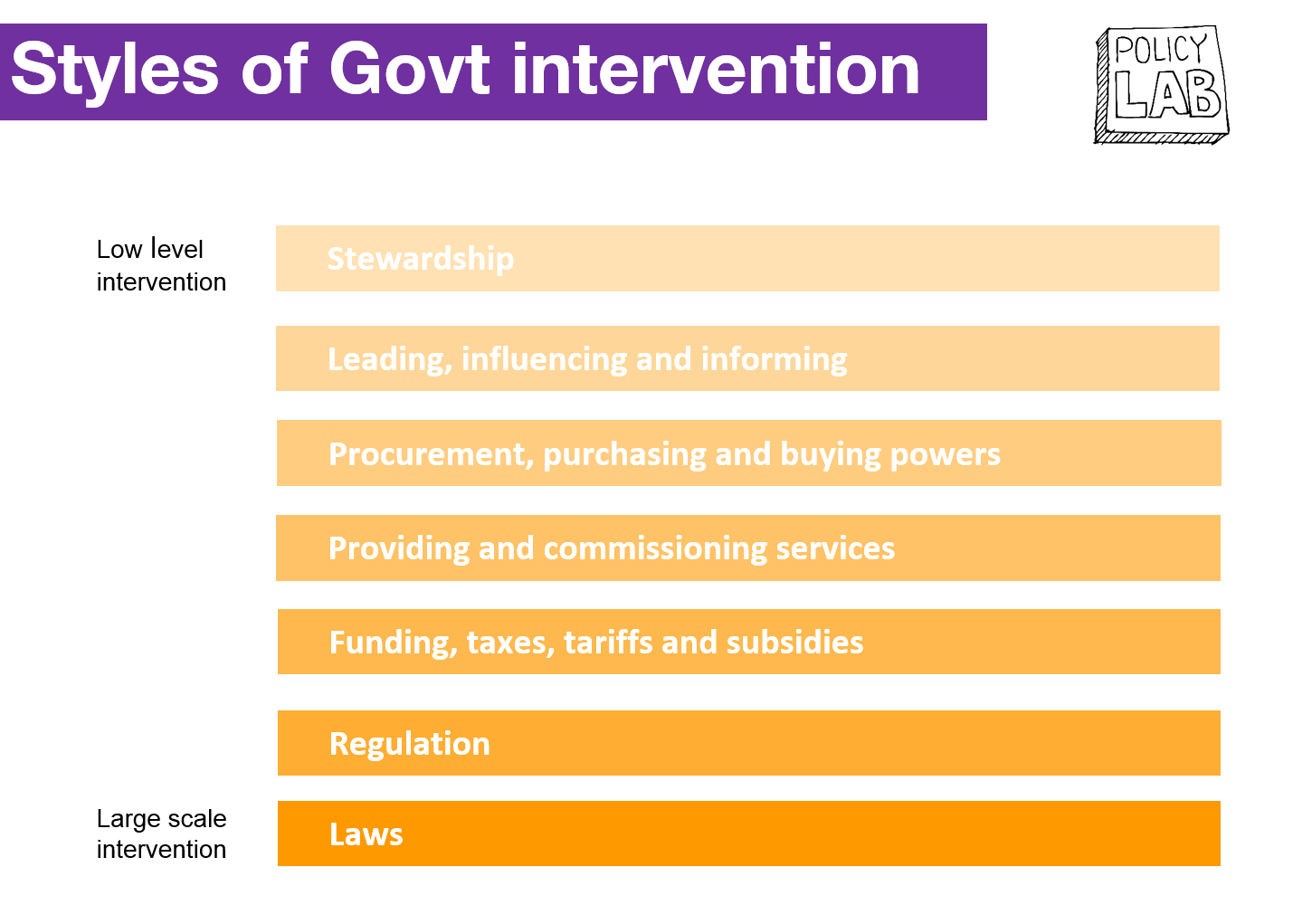
International trade issues are all over the news. Brexit and relations between China and the United States are dominated by how easily companies in one country can access markets in another, and whether they have the competitive advantages to win customers and grow
Governments have a role in boosting the competitive advantage of their country’s exporters, but how do they do it?
At the Open Data Institute (ODI), we are in the middle of a research project on how the quality of a country’s data infrastructure might affect its trade competitiveness in data-enabled goods and services. We recently needed to map the interventions that governments in places such as Australia, Canada, and the United Kingdom are making to boost trade competitiveness, and realised that’s not as easy as one might think.
Styles of government intervention tool
The UK Cabinet Office's Policy Lab styles of government intervention tool offered a good way to do that. It’s an application of service design to government which shows the ‘patterns’ in public interventions. It is actually more like a toolbox than a tool, in that you use it by working out which category a government intervention fits into, leading to a full view of government roles – like stewarding or regulating, in nascent or mature areas. We’ve been keen to use the tool for a while.

The result is our UK styles of government intervention in trade competitiveness document, which collects things like the UK Export Finance trade fairs, the Africa Infrastructure Board, and National Trade Academy Programme in one place. Using the tool quickly gave us a broad view that showed us the government’s multiple roles.
Boosting trade competitiveness
We focused on things the UK government could affect in the short term to boost trade competitiveness, rather than things that it could change through amending international agreements. You might say that we should have mapped interventions by international bodies on top of those by UK bodies, but that might have made the results unwieldy before we had understood them.
We also didn’t investigate sector-level government interventions or consider how public institutions such as the law courts and universities play a role. They affect trade competitiveness – eg maintaining a stable business environment and raising workers’ skill levels – but including them would have likely led to just filling all the boxes, perhaps reducing the tool’s usefulness.
We found it easy to populate the categories, and it was interesting to see that the UK’s trade competitiveness interventions seem to cluster around the UK government as a steward and leader – both at the low end of the intervention scale – little as a regulator, and with some significant interventions as a legislator. This makes sense in trade, given that a state with a worldwide network of connections such as the UK’s would use them to help domestic producers to learn about foreign opportunities. And given that setting trade rules between developed countries are likely to be at least a bilateral process, there seem to be only a few ways in which the UK government acts as a regulator by itself, such as the Trade Remedies Authority's role in protecting domestic industries against unfair competition.
There are things that the tool doesn’t show – by design. For example, the amount of spending on interventions in one category might be much bigger than in another, but the latter might have a greater number of interventions. Our allocation of some UK government interventions to one category rather than another is also debatable – Economic Partnership Agreements and bilateral investment treaties seemed best captured by the tool’s description of interventions that are about ‘reviewing, identifying, and prioritising key opportunities with strategic value’ but perhaps they’re just another way for connecting networks for ‘scaling, mainstreaming, and market building’.
Data portability, and exploring open data changes in Ukraine
We also played with the tool in a couple of other areas of interest to the ODI: data portability, and the open data and government transparency changes in Ukraine:
- The former helped us to see more clearly that government interventions for data portability are asking officials to take stewarding and leadership roles while updating legislation on data protection and related areas at the same time. Perhaps a new way for spotting when legislators might be more likely to write flexible laws that need to be interpreted, rather than be highly prescriptive.
- The latter helped us to map what we expected in Ukraine: that the drive for open data and transparency in Ukraine was new, and that reformers and international development organisations have been making a raft of early-stage interventions.
Next steps
The styles of government tool has given us some more organised insight into our areas of interest, and we’ll be applying it to the trade competitiveness interventions of more countries as our international trade project continues. At the moment it looks like it could be most useful at two points: when we’re trying to get a handle on what a government is doing, which is what we have done so far; and when we have a much deeper understanding and are able to perhaps develop ‘intervention models’ that show policymakers the mix of roles they might adopt to achieve something.
Get involved
You can help us and the wider community that might be interested in the styles of government tool, by commenting on our use of it, suggesting better categorisations or telling us where we have missed things. Policymaking is naturally a question of things like rules, incentives, and coordination, but using design to identify roles looks to us like a handy approach that we would like to get better at, and help others to do the same.
Mapping the UK’s trade competitiveness interventions has helped us in the past few months. As we use the tool more on our project, we’ll share more applications.